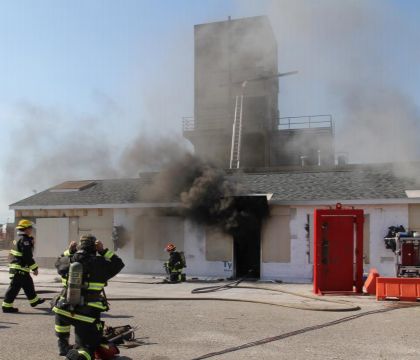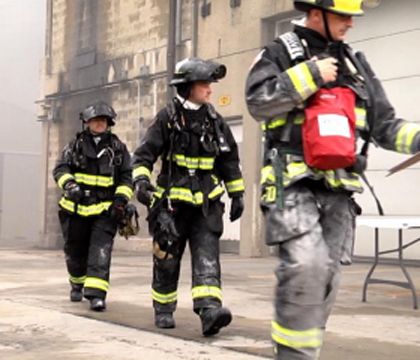Purposes of the study
This study was designed to better understand how operating in a modern fire environment is related to the two leading health issues facing firefighters; namely cardiovascular events and chemical exposures related to carcinogenic risk. We investigated the impact of different tactics (traditional interior attack vs a transitional attack) and different firefighting location/assignment (interior attack, outside operations, outside command, overhaul) as well as measures such as skin cleaning and gross on scene decon to affect these risks.
Motivation for study
Significant advances have been made in our understanding of the hazards associated with structural firefighting.
- Research has provided a greater understanding of the development, propagation and dangers of modern residential fires. The fire service has been provided with important tactical guidance that may potentially increase firefighter effectiveness while decreasing risk.
- Sudden cardiac events are the leading cause of duty-related deaths among firefighters and they are far more likely to occur after fire suppression activity. Substantial evidence suggests that firefighting leads to significant cardiovascular strain.
- Firefighters have an increased risk for several types of cancer. Fires produce hundreds of toxic compounds. Some are carcinogenic like benzene and certain polycyclic aromatic hydrocarbons (PAHs).
Despite these advances in understanding, important questions remain.
- What is the physiological and chemical impact of the different exposures experienced by firefighters employing differing tactics and conducting various job assignments on the fireground?
- How do factors related to firefighting effect cardiovascular responses under realistic modern fire environments? How effectively does the body recover over the 12 hours following a response?
- How — and at what levels — do toxic combustion products get into a firefighter’s body? How much of the absorbed dose comes from skin absorption versus inhalation.
Methodology
In order to safely and reliably conduct typical firefighting operations and tactics with 12 person crews, we designed and built a structure that had all of the interior finishes, fuel loads and features common in the 21st century, yet contained safety systems and hardened construction techniques that ensured our participants’ safety.
During this study, we measured:
- The production and transfer of thermal energy as well asthe magnitude and composition of gasses and particles in the fire environment.
- Contamination of firefighters’ personal protective equipment and skin.
- Absorption of that contamination into the firefighters’ bodies.
- How these variables were influenced by tactical decision (interior only vs. transitional attack) and operating location (interior fire suppression vs. exterior operations vs. interior overhaul).
Specifically:
- Temperature, heat flux, oxygen, carbon monoxide and carbon dioxide were measured throughout the structure to characterize risks for firefighters as well as potentially trapped occupants.
- A variety of chemical compounds were evaluated in the air surrounding firefighters during the fires, as well as in the fireground. Firefighters wore SCBA when inside the structure, but did not always wear SCBA when on the fireground.
- The chemical compounds (or their metabolites) found in urine, blood or breath were characterized before and after firefighting. This tells us what was absorbed into the firefighters’ bodies.
- Contamination on neck and hand skin was assessed after firefighting. We also determined the effectiveness of using commercial skin wipes to clean the neck area.
- Volatile and non-volatile contamination on turnout gear was measured after firefighting and after three types of field-based decontamination methods.
We assessed cardiovascular responses to firefighting and to specific tactics and operating location by assessing ECG responses, blood chemistry and coagulatory measures and vascular responses during and up to 12 hours following firefighting.
 Preliminary results
Preliminary results
The results presented in this summary of the interim report are a small subset of the data that was collected. We cannot make any definitive conclusions until we perform a comprehensive analysis of all the data. These results are provided to alert the fire service of the study and its complexities, provide a glimpse of what we are finding and to prepare the fire service for future publications and other outputs. For example, results from skin and biological exposure monitoring (blood, urine and breath) are still pending. The results provided below are only examples of data from one or two scenarios, but we believe to them to be fairly representative of the typical study results.
- For the first time, the variability in interior structure temperatures, heat flux and gas concentrations that result from different, yet common, fireground operations (different crews and two separate tactics in the same fire scenario) have been quantified in a controlled manner.
- The impact of tactics on exposures of trapped occupants has also been quantified to better understand the risks and benefits of firefighter activities on the potential victims.
- Firefighters’ core temperatures and skin temperatures were strongly affected by the fireground job assignment. Activities such as outside vent and overhaul resulted in elevated temperatures even though the firefighters were not operating on the interior of the structure while the fire was burning.
- Blood clotting potential appears to be strongly related to fireground job function.
- We detected a variety of flame retardants in the fuel package materials used for all fires and in the air inside the structure.
- Air sampling from within the structure during active fire on one day showed hydrogen cyanide levels that were nearly seven times the Immediately Dangerous to Life and Health (IDLH) level and benzene levels that were up to 15 times exposure limits. These and other volatile compounds were also detected inside the structure during overhaul and on the fireground, but at levels below applicable exposure limits.
- Based on two days of sampling, two important sources of particulate were identified on the fireground: smoke plume from the fire and diesel exhaust from the fire apparatus. The contribution of both sources is dependent on the wind direction.
- Several flame retardants and PAHs were detected on turnout gear items after use in a fire. Gross on-scene decon with water/detergent and scrubbing was effective in bringing the PAH contamination to pre-fire levels.
- Volatile compounds like hydrogen cyanide and benzene were measured off-gassing from turnout gear after use, but at levels below applicable exposure limits. Off-gas levels returned to background within an hour regardless of whether or not the turnout gear were decontaminated.
Next steps
Again, these results presented in this interim report are only a snapshot of what has been collected and is currently being analyzed. A detailed fire service toolkit is scheduled to be released in 2017 with a comprehensive overview of the information available and tactical considerations. The toolkit will be freely available to firefighters and fire officers around the globe. You can keep up to date with information being released through:
- IFSI or on Twitter @IFSIresearch
- UL FSRI, their Facebook page or on Twitter @UL_FSRI












